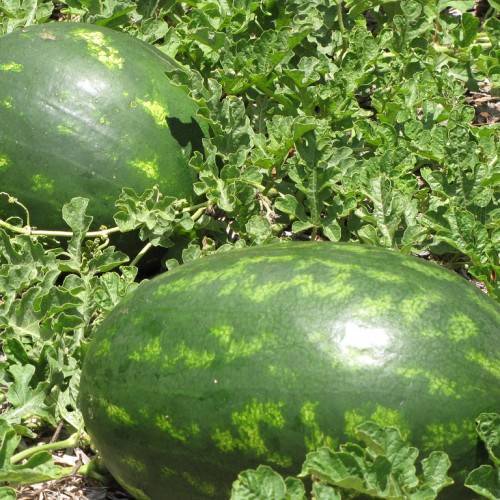
watermelon
Citrullus lanatus
Cycle:
Annual
Watering:
Average
Hardiness Zone:
2 - 11
Flowers:
Flowers
Sun:
full sun
Soil:
Well-drained
Fruits:
Fruits In Summer Ready In Summer
Edible:
Yes
Leaf:
Yes
Growth Rate:
High
Maintenance:
Moderate
Drought Tolerant:
Yes
Salt Tolerant:
Yes
Care Level:
Medium
watering
Watermelons need a lot of water, especially during the hot summer months. To successfully grow watermelon, water the plant when the top 1-2 inches of the soil is dry. Water deeply and slowly, soaking the soil evenly so that the water reaches the roots. If water runs off of the soil, wait 20 minutes and then water again. Allow the soil to dry slightly between waterings. Water the plants 2 to 3 times a week with 2-3 gallons of water per plant. Avoid wetting the foliage while watering. During a prolonged dry period, or if temperatures exceed 90°F, increase watering to once per day.
sunlight
Watermelons require 8 to 10 hours of direct sunlight each day for optimal growth and development. This species of plant grows best in areas with full sun, which is defined as at least 6 hours of direct sunlight, or 8 to 10 hours of sun with some light shade during the hottest parts of the day. For best results, watermelons should receive the majority of their sunlight during the morning hours. Too much direct sunlight during the afternoon can cause the plant's leaves to sunburn, resulting in lower yields. Watermelons are also at risk of diseases, such as powdery mildew, when grown in shady conditions.
pruning
Watermelon (Citrullus lanatus) should be pruned shortly after planting. This should involve removing any weak or unhealthy seedlings. After the plant is established, begin by pinching off any lateral runners that are growing away from the main stem, leaving only a few of the strongest ones. Throughout the growing season, selectively prune off older leaves and stems to promote better air circulation and to prevent disease. Pruning of watermelon plants should be done in early to mid-summer as the plant matures. As the vines begin to produce melons, pinch off the ends of the main runners to establish a final trail. Make sure that the fruits are left with enough foliage to protect them from sunburn. Finally, up to 1 week before harvest, remove any remaining vine tips to focus energy on ripening the existing melons.
Propagation
Season
Hardiness Map
FAQ
Is watermelon a good source of hydration?
Yes, watermelon is a great source of hydration. It is about 92% water and rich in electrolytes for hydration. It is also an excellent source of vitamins A, C, and B-6, as well as potassium. The electrolytes and water content of watermelon can help replace lost fluid and electrolytes, making it a great post-exercise snack. Watermelon is also low in calories, so it can be a great way to rehydrate without over-consuming calories.
Are watermelons good for weight loss?
Yes, watermelons can be a great food for weight loss. Watermelon is low in calories and rich in fiber making it a great snack to keep you feeling full and help you to avoid overeating. Additionally, watermelon is rich in essential vitamins and minerals including vitamin C, potassium and magnesium, as well as antioxidants which help to support overall health and wellness. Eating watermelon can help you to stay hydrated and can give you the required energy for a healthier lifestyle.
Should watermelons be refrigerated before eating?
Yes, it is recommended that watermelons be refrigerated before eating. Not only will refrigerating the fruit make it taste better, but it will also help preserve it for a long period of time. Refrigerating the watermelon will help keep it fresh and crisp, and make it more enjoyable to eat. It is also important to store any leftover watermelon in the refrigerator so that it does not spoil.
